Embrace the Gulf
(Updated November 2021)
Spanning over 1,600 miles of shoreline, the Gulf of Mexico is the world’s ninth-largest body of water and provides significant natural and economic resources to the region and beyond. The area’s 15.6 million acres of wetlands—including bays, estuaries, barrier islands, and mangrove swamps—represent half of the coastal wetlands in the entire United States. In terms of economics, if the Gulf of Mexico region were a country, it would rank in the top 10 worldwide based on gross domestic product.
Sugar-white sand beaches, recreational fishing, and rich cultural traditions such as Mardi Gras draw in visitors from around the world, creating more than 2.6 million jobs in the tourism industry. The region also provides 40% of the United States’ total petroleum refining capacity and 33% of the nation’s commercial seafood production.
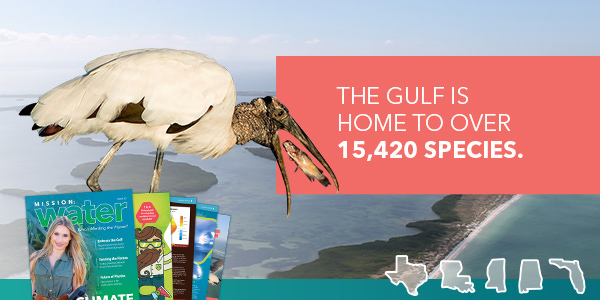
Photo Credit: GOMA
Unique Challenges
While the region is valuable both economically and environmentally, natural and man-made hazards are also a reality of life.
All five Gulf states face challenges, including hurricanes and coastal flooding, harmful algal blooms, and marine debris. The Gulf of Mexico region is also the fastest-growing coastline nationwide, increasing in population by over 25% since 2000. This population boom has placed more pressure on an already delicate ecosystem.
Major hurricanes, flash floods from rainstorms, and chronic tidal flooding are all threats to people and communities. These events flood low-lying areas and damage critical infrastructures like roads and schools. With sea-level rise, sunny-day flooding is increasing along the Gulf coast as well. Sea level rise pushes water even higher during high tides and causes flooding even on days when there are no storms.
Harmful algal blooms (HABs) of red tide occur each year in Texas and Florida, and, in recent years, red tide has also appeared in Alabama, Mississippi, and Louisiana. The organism that causes most red tides (Karenia brevis) releases a toxin that can cause fish kills, as well as coughing, wheezing and skin irritation for people.
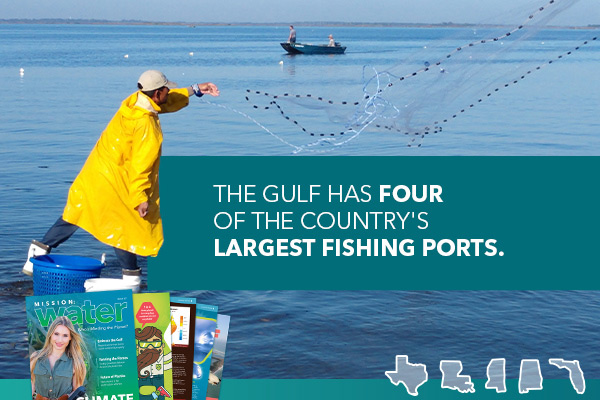
Photo Credit: GOMA
Blue-green algae (cyanobacteria) blooms typically occur in freshwater but became an important emerging issue in Mississippi and Louisiana in 2019 after significant releases of floodwater from the Mississippi River lowered salinity in coastal estuaries. Toxins from these bacteria can also cause health problems and affect seafood. Because of these events, HABs have resulted in millions of dollars lost across the region’s tourism, commercial fishing, and real estate industries.

Marine debris is a global problem, including in the Gulf of Mexico. Any man-made trash in the water, from cigarette butts to abandoned boats, is considered marine debris. Most marine debris comes from plastic, and these pollutants eventually break down into tiny pieces of marine debris called microplastics.
Fish and other animals ingest these small microplastics assuming they are food; the animals feel full and can eventually starve. Microplastic concentrations in the Gulf are similar to some of the highest numbers reported worldwide.
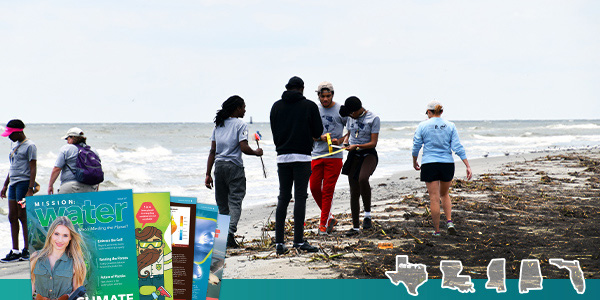
Photo Credit: Alma Robixhaux
Partnerships for a Healthier Gulf
The Gulf of Mexico Alliance (GOMA) recognizes building collaborative partnerships is the way to address environmental and economic challenges in the Gulf region. The Alliance has built a unique partnership of state and federal agencies, local governments, non-profits, academics, and businesses who work together to address regional challenges.
The Alliance has supported numerous communities in projects that incorporate science into their planning, help improve stormwater management, and lower flood insurance rates. These projects help increase awareness of the ways human and aquatic health are tied to the economic strength of the region.
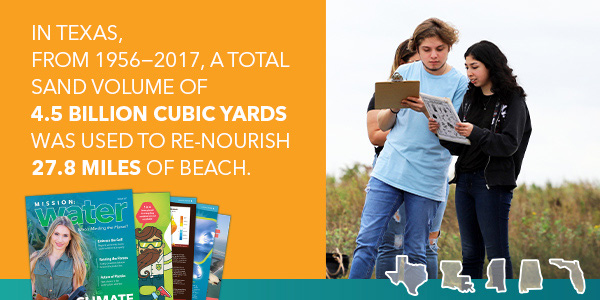
Photo Credit: GOMA
To help promote individual resilience, GOMA and its partners have prepared a Homeowners Handbook with small, cost-effective steps to protect families and property from hurricanes and floods.
- One recent project has focused on expanding autonomous underwater vehicle (AUV) glider deployments to understand where red tide blooms begin in Florida. This information is critical for seasonal forecasting and limiting beach closures that impact tourism.
- To further understand the financial impact of HABs, economists are comparing metrics connecting Florida red tide events to tourism, housing sales, and fishing activity. Early results from this new project show Google search trends and social media posts about red tides are highly correlated with customers canceling hotel rooms, dinner reservations, and fishing trips. Even on days when no red tide is present, news stories and social media shares can change customer behavior.
- Another project has supported the development of a handheld genetic sensor that allows scientists to more easily detect toxic and non-toxic species of algae, improving response decisions by fishery managers responsible for preventing foodborne illness.
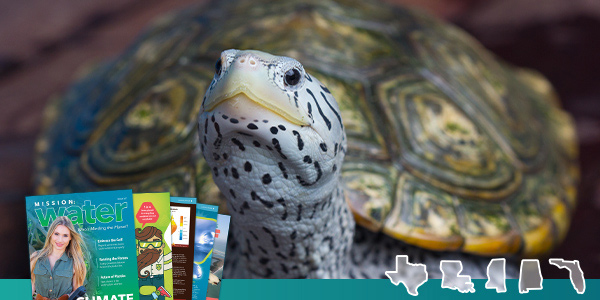
The Diamondback Terrapin is a native turtle with one of the largest ranges of all turtles in North America. Stretching as far south as the Florida Keys and as far north as Cape Cod, it calls the brackish coastal swamps of eastern and southern United States home.
GOMA Tackles Plastic Pollution
Other GOMA projects help to assess, reduce, prevent, and eliminate marine debris in the Gulf of Mexico. Businesses that no longer want to employ single-use plastics such as straws and utensils have been given funding to make the initial switch to new products—skipping the plastic can have an immediate impact on reducing pollution.
A local Mississippi restaurant reduced its single-use plastics by 80%, which included eliminating the use of 4,000 plastic straws each week.
Citizen scientists across the entire Gulf region are now sampling microplastics in water and sand for several GOMA projects, building a database and online map used by scientists and the public to better understand the amount and location of plastic pellets, fibers, and fragments along the shoreline. Volunteers lead regular cleanup events to remove trash from beaches and collect additional data for scientists on the types of debris they find.
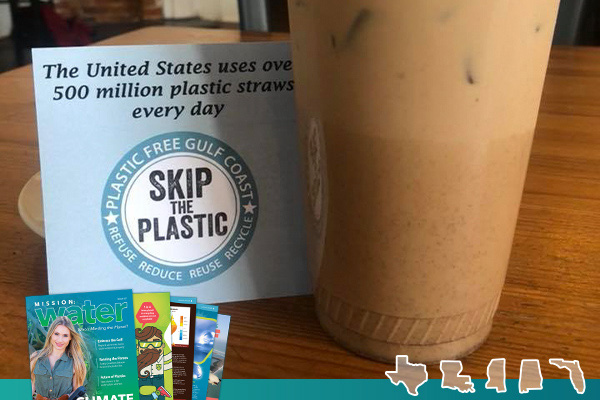
GulfofMexicoAlliance.org
Making A Difference
The Alliance and its partners continue to collaborate in new ways to create tangible, impactful changes in the Gulf. This includes a unique social media campaign to “Embrace the Gulf” launched in January. Embrace the Gulf shares positive messages and encourages simple actions that everyone can act on to make a difference, including skipping single-use plastics and choosing to eat sustainable seafood.
Citizens can become directly involved in GOMA’s programs by joining a Priority Issue Team. Each team focuses on a different issue, such as coastal resilience, education & engagement, and water resources. Teams hold regular meetings to discuss their projects and to identify new ways to enhance the health of the Gulf of Mexico.
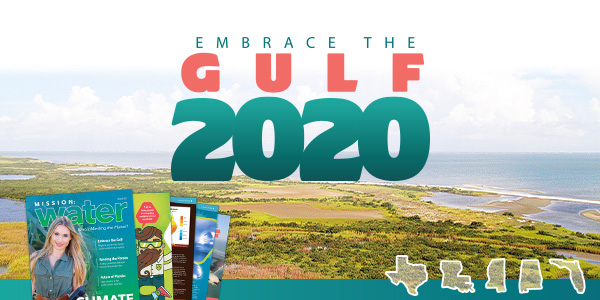
About Embrace The Gulf
The “Embrace the Gulf” initiative is a year-long awareness campaign for 2020 highlighting the vitality, sustainability, beauty, and productivity of the Gulf of Mexico with a series of daily messages shared across Facebook, Twitter, and Instagram.
The Alliance is highlighting five focus areas that make the Gulf of Mexico a special place: resilient coastal communities, prosperous industries, superior educational opportunities, thriving tourism, and healthy ecosystems.
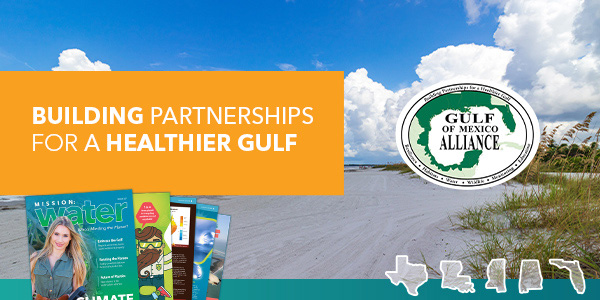
About The Gulf of Mexico Alliance
The Gulf of Mexico Alliance is the Regional Ocean Partnership for the Gulf of Mexico, designated by the governors of the five Gulf States—Alabama, Florida, Louisiana, Mississippi, and Texas. Since 2004, the Alliance has significantly increased regional collaboration to enhance the environmental and economic health of the Gulf of Mexico. Led by the states, their network includes 150 participating organizations and nearly 1,000 members from state and federal agencies, local government, academia, non-profits, and business/industry.
Recent work includes capacity and resilience building in 21 coastal communities across the Gulf, hosting numerous regional workshops and trainings, creating an open data platform to improve habitat data access, and managing a major regional program to initiate new research following the Deepwater Horizon Oil Spill.
For More Information about GOMA and the “Embrace the Gulf” Campaign:
Social Media | Facebook: @GOMAlliance | Twitter: @GOMAlliance | Instagram: @gulfofmexicoalliance
Contact | Becky Ginn: becky.ginn@gomxa.org | Website: GulfofMexicoAlliance.org
